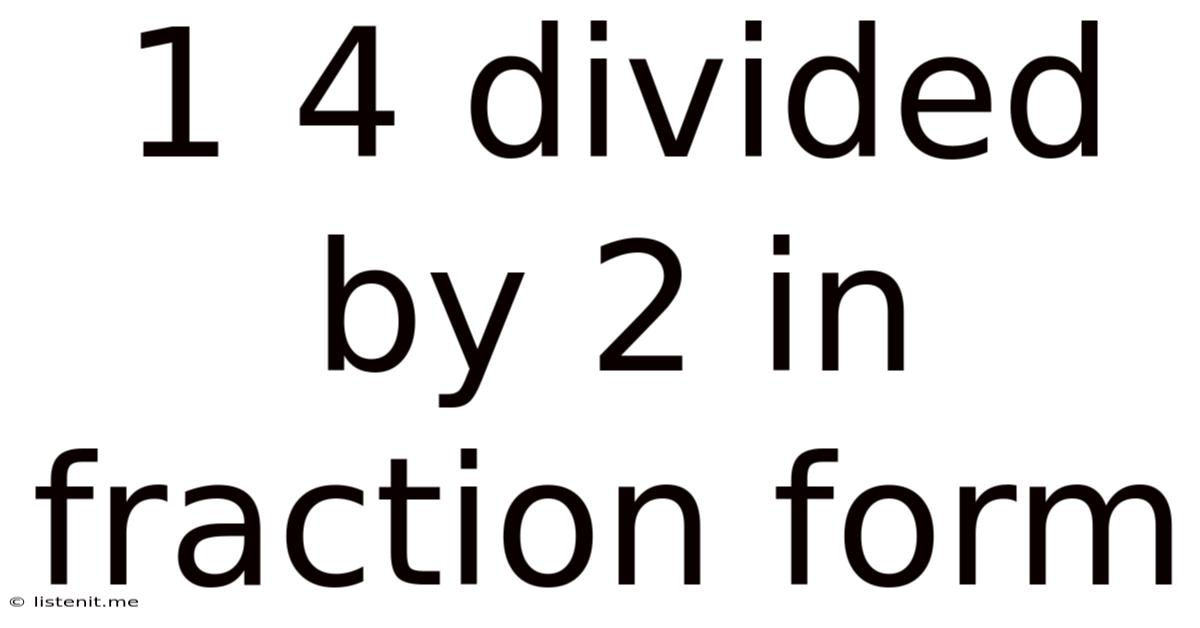1 4 Divided By 2 In Fraction Form
listenit
May 24, 2025 · 5 min read

Table of Contents
1 1/4 Divided by 2: A Comprehensive Guide to Fraction Division
Dividing fractions can seem daunting, especially when mixed numbers like 1 1/4 are involved. However, with a clear understanding of the process and some practice, it becomes straightforward. This article will delve into the intricacies of dividing 1 1/4 by 2, explaining each step in detail and providing additional examples to solidify your understanding of fraction division.
Understanding Fractions and Mixed Numbers
Before tackling the division problem, let's refresh our understanding of fractions and mixed numbers.
Fractions: A fraction represents a part of a whole. It consists of two parts: a numerator (the top number) and a denominator (the bottom number). The numerator indicates the number of parts we have, while the denominator indicates the total number of equal parts the whole is divided into. For example, in the fraction 3/4, 3 is the numerator and 4 is the denominator. This means we have 3 out of 4 equal parts.
Mixed Numbers: A mixed number combines a whole number and a fraction. For example, 1 1/4 represents one whole unit plus one-quarter of another unit.
Converting Mixed Numbers to Improper Fractions
To divide fractions effectively, it's usually easier to work with improper fractions. An improper fraction has a numerator that is greater than or equal to its denominator. Let's convert 1 1/4 into an improper fraction:
- Multiply the whole number by the denominator: 1 * 4 = 4
- Add the numerator to the result: 4 + 1 = 5
- Keep the same denominator: The denominator remains 4.
Therefore, 1 1/4 is equivalent to the improper fraction 5/4.
Dividing Fractions: The Reciprocal Method
The most common method for dividing fractions involves using the reciprocal. The reciprocal of a fraction is simply the fraction flipped upside down. To divide two fractions, we multiply the first fraction by the reciprocal of the second fraction.
In our case, we want to divide 1 1/4 (which is 5/4) by 2. First, we need to express 2 as a fraction: 2/1.
Now, we can rewrite the problem as:
(5/4) ÷ (2/1)
To solve this, we multiply 5/4 by the reciprocal of 2/1, which is 1/2:
(5/4) x (1/2)
Multiplying Fractions
Multiplying fractions is relatively straightforward:
- Multiply the numerators: 5 x 1 = 5
- Multiply the denominators: 4 x 2 = 8
This gives us the result: 5/8
Therefore, 1 1/4 divided by 2 is 5/8.
Simplifying Fractions
In this case, the fraction 5/8 is already in its simplest form. A fraction is in its simplest form when the greatest common divisor (GCD) of the numerator and denominator is 1. In other words, there's no whole number (other than 1) that divides both the numerator and the denominator evenly. If the fraction wasn't in its simplest form, we would need to simplify it by dividing both the numerator and denominator by their GCD.
Visualizing the Division
It can be helpful to visualize the division process. Imagine you have a pizza cut into four slices (representing 1 1/4 pizzas, where 1 is a whole pizza and 1/4 is a single slice). You want to divide this total amount equally between two people. Each person would receive 5/8 of a pizza.
Practical Applications
Understanding fraction division has numerous practical applications in everyday life, including:
- Cooking and Baking: Scaling recipes up or down requires dividing fractions.
- Sewing and Crafts: Calculating fabric or material requirements often involves fractions.
- Construction and Home Improvement: Measuring and cutting materials necessitates accurate fraction calculations.
- Financial Calculations: Sharing costs or dividing profits often uses fractions.
Further Examples of Fraction Division
Let's work through a few more examples to reinforce your understanding:
Example 1:
3 1/3 ÷ 1/2
- Convert 3 1/3 to an improper fraction: (3 * 3 + 1) / 3 = 10/3
- Find the reciprocal of 1/2: 2/1
- Multiply: (10/3) x (2/1) = 20/3
- Convert back to a mixed number: 6 2/3
Example 2:
2 1/2 ÷ 5/4
- Convert 2 1/2 to an improper fraction: (2 * 2 + 1) / 2 = 5/2
- Find the reciprocal of 5/4: 4/5
- Multiply: (5/2) x (4/5) = 20/10
- Simplify: 20/10 = 2
Example 3:
1/4 ÷ 3/8
- Find the reciprocal of 3/8: 8/3
- Multiply: (1/4) x (8/3) = 8/12
- Simplify: 8/12 = 2/3
Troubleshooting Common Mistakes
- Forgetting to find the reciprocal: Remember, you multiply by the reciprocal of the second fraction, not the second fraction itself.
- Incorrect conversion to improper fractions: Make sure you accurately convert mixed numbers to improper fractions before proceeding.
- Errors in multiplication: Double-check your multiplication of numerators and denominators.
- Failing to simplify: Always simplify your final answer to its lowest terms.
Conclusion
Dividing fractions, particularly mixed numbers, might seem challenging at first, but by systematically following the steps – converting to improper fractions, finding the reciprocal, multiplying, and simplifying – you can master this essential mathematical skill. Practice makes perfect, so work through various examples, and soon you'll be confidently tackling any fraction division problem that comes your way. Remember the visual aids and real-world applications to keep the concept engaging and relevant. By understanding the underlying principles and practicing regularly, you'll develop a strong foundation in fraction arithmetic.
Latest Posts
Related Post
Thank you for visiting our website which covers about 1 4 Divided By 2 In Fraction Form . We hope the information provided has been useful to you. Feel free to contact us if you have any questions or need further assistance. See you next time and don't miss to bookmark.